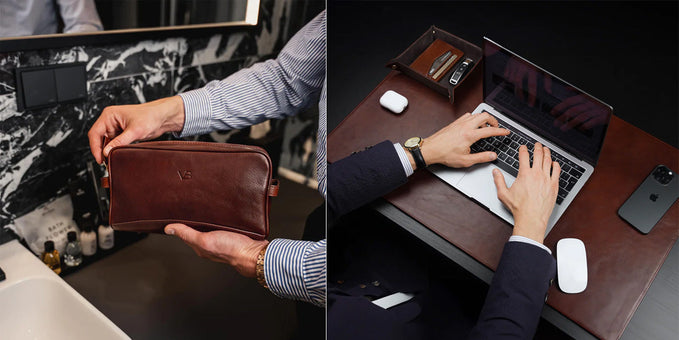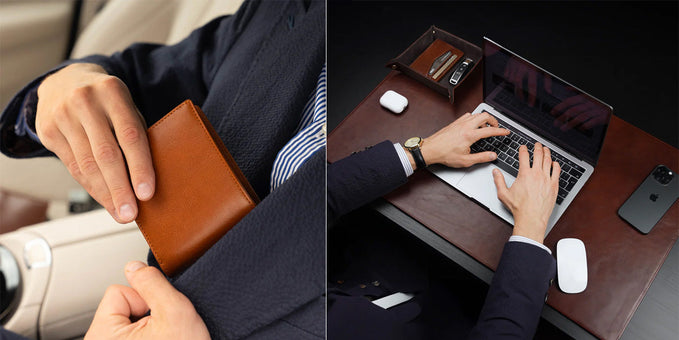History of Wallets

Invention & Origin of the Word "Wallet"
Wallets were first invented as simple pouches used to carry coins and valuables in the 1300s.
The word "wallet" originates from Old English and Proto-Germanic roots, particularly the word wællan, meaning “roll” or “bundle.” Initially, it described a container for small valuables. Over time, it evolved to refer to the slim, organized cases we know today, especially as "wallet" became popular in the Elizabethan era.
The modern bifold wallet was invented in the mid-20th century.
There isn't one known "inventor" of the wallet; there was simply a cultural shift from larger pouches to the compact wallets we use today.
Need a new wallet? Von Baer makes the finest quality full-grain vegetable-tanned leather wallets.

Historical Timeline
- Ancient Pouches: Essential for daily exchanges, providing portability and security.
- Renaissance Billfolds: Adapted for paper currency, combining utility with elegance.
- Industrial Identity: Carriers became personal identifiers, holding mementos and essential items.
- Modern Card-Ready Designs: Designed for today’s fast-paced environments, emphasizing organization and accessibility.
- The Digital Age: Despite mobile options, physical wallets retain their value as tangible symbols of personal history and style.
How Wallet Design Evolved Over Time
Introduction to wallets
First used to carry provisions, including food, wallets have become highly sophisticated items for personal belongings.
Their move from acting as simple survival packs to modern accessories shows how identity security and personal financial management have evolved.
The term “wallet” was first used in the late 14th century.
Ancient wallets

In ancient civilizations such as Greece, the wallet wasn’t just used to hold coins. It was also regarded as a survival pack.
These wallets were manufactured from materials including cloth and leather.
They quickly became essential to people’s lives and reflected the age’s art, culture, and practical requirements.
Imagine the lively Greek agora, where merchants, nobles, and travelers gathered. In that environment, a discreet, secure carrier for valuables was essential. These pouches quickly became indispensable, signaling that the owner was involved in commerce and travel. For those safeguarding valuables on the move, these pouches reflected status and responsibility—qualities many aspired to embody.
Medieval and Renaissance wallets
When paper currency was introduced in the 1600s, the modern wallet started to emerge.
Early Renaissance wallets were mainly made from cow or horse leather. They had a small pouch for printed calling cards.
This reflected a move towards greater organization or personal finance.
Wallets in the modern age
Wallets became more refined and pocket-sized between the 17th and 19th centuries.
This reflected society’s movement towards a more urban, mobile way of life.
20th-century wallets

Various innovations emerged in the 20th century.
The bi-fold wallet became incredibly popular in the 1950s when credit cards emerged.
The Velcro-closure wallet was introduced in the 1970s and was ideal for an increasingly fast-paced world.
The image above is of this leather bifold wallet.
Technological advancements and wallets
Credit cards played a big role in reshaping wallet designs and offered slimmer options with dedicated slots.
The emergence of digital and cryptocurrency wallets reflected how finance was increasingly digitized and the growing need for digital security.
The digital age and wallets

The move towards digital wallets shows a significant shift in how people manage their finances.
Digital wallets and mobile payment systems are swiftly becoming the norm.
Why We Call It a "Wallet" and the Word’s Origins
The term “wallet” itself has ancient roots that speak to the function of these carriers. Originating from Old English and Proto-Germanic words like wællan, meaning “roll” or “bundle,” the term captures the original purpose of these containers: to hold small valuables securely. Over time, the word evolved along with the object’s design, moving from larger bags to the slim, organized cases familiar today.
By the Elizabethan era, “wallet” was commonly used to describe a practical, everyday accessory. With paper currency in the 17th century, English merchants and noblemen began carrying "billfolds," a new structure that met the needs of handling paper money. This shift in language and form solidified “wallet” in English as a trusted, versatile companion for daily use. Through centuries of subtle transformation, the term came to signify both reliability and personal significance.
Practical Tip: Our words often influence our perceptions of the things we carry. The idea of a “wallet” as a protected, organized bundle encourages choosing a model that fits your daily needs, whether for added security, multi-purpose functionality, or sleekness.
| Aspect | Summary |
|---|---|
| Invention | 1300s: First wallets as pouches for coins and valuables. |
| Word Origin | Old English & Proto-Germanic "wællan" (roll/bundle), used in Elizabethan times. |
| Evolution |
|
| Modern Wallet | 20th-century bifold, Velcro in 1970s, digital wallet options today. |
| Material & Design | Leather, fabric, and eco-materials; innovations include RFID protection. |
| Global Shift | Increasingly cashless; digital wallets on mobile devices becoming standard. |
| Cultural Significance | Symbolizes wealth in some cultures; function varies widely. |
Compatibility
Digital wallets break down boundaries between currencies. They offer seamless integration across platforms and devices. Their ongoing popularity is partially down to their universality.
Wallets in different cultures
Wallets have different meanings and uses across cultures.
In some cultures, they are only functional, but in others, they have vast symbolic significance and can represent great prosperity and wealth.
Trends and popular brands
The wallet industry still sees frequent changes when it comes to trends.
Technology, fashion, and consumer preferences have been highly influential in the evolution of the wallet.
The world’s leading brands set many trends.
The most fashionable wallet right now is the leather bifold wallet.
Sustainability and ethical considerations
There has been a big rise in ethical and sustainable production regarding how wallets are made.
Consumers are increasingly aware of environmental impact, which has led to more brands using recycled materials and following fair labor practices.
Emerging technologies
Various technologies are being integrated into wallets. These include solar charging, flexible displays, and biometrics. RFID protection is also popular in 2024, with the increased risk of cyber crime.
Cashless transactions
The worldwide shift towards cashless transactions is reshaping the role of the wallet. Digital wallets hint at a future where physical wallets could become obsolete.
There has been a large rise in the use of mobile payments, which represents a large shift compared to the previous 50 years.

Author: Albert Varkki
Albert Varkki is the co-founder of Von Baer. He understands leather products as a consumer, supplier, and a manufacturer, helping you with the inside knowledge you need, to choose the perfect leather product for you.
We strive for the highest editorial standards, and to only publish accurate information on our website.
Leave a Comment
Your email address will not be published.






